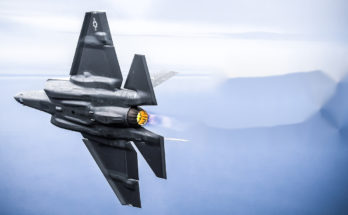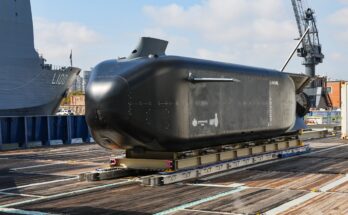by J. Kasper Oestergaard, European Correspondent, Forecast International.

The A330 MRTT, A400M, C-295 and Eurofighter Typhoon lined up for takeoff in Seville, Spain, during a 2019 formation flight celebrating Airbus’ 50th anniversary. The Spanish defense industry plays a key role on all Airbus commercial and military aircraft programs. Image. Airbus SAS
From humble beginnings and isolation during the Francoist dictatorship, Spain has become one of the world’s leading producers and exporters of aerospace & defense equipment and recently joined the Future Combat Air System (FCAS) project, which includes the development of a next-generation fighter jet to replace the Eurofighter Typhoon and Dassault Rafale.
According to Forecast International’s International Military Markets research, over the past two decades, Spanish defense investment has reflected a whipsaw driven by economic realities. When Spain’s economy – and that of the larger Eurozone – has experienced healthy stretches, the nominal topline defense budget has undergone a parallel track. During periods of slow growth or outright recession, the defense budget has suffered. In 2019, Spain’s defense spending is expected have risen by 0.9% to EUR8.5 billion ($9.7 billion).

In late 2018, the Spanish government approved an investment package worth EUR7.3 billion ($8.3 billion) that covers defense and security programs within a multiyear period culminating in 2032, including three major defense projects involving an order of five F110 class multi-mission frigates as well as new 8×8 wheeled armored vehicles for the Spanish Army, and an upgrade and modernization of the Air Force’s fleet of 73 Eurofighter Typhoon multi-role fighter jets.
According to the Stockholm International Peace Research Institute (SIPRI), with 2018 arms exports amounting to $1.2 billion, Spain is the third biggest arms exporter in Europe and ranks fifth in the world. Over the five-year period from 2014 to 2018, aircraft account for the majority of Spain’s exports, followed by ships and sensor systems. The country’s top exports were C295 transport aircraft and A330 MRTT tankers, Hobart class destroyers, and Ajax (Scout SV) armored fighting vehicles. Airbus, Navantia, General Dynamics European Land Systems, Indra Sistemas, and Sociedad Anónima de Electrónica Submarina (SAES) were the major Spanish arms exporters.
The International Trade Administration (ITA), a U.S. Department of Commerce agency, estimates the value of Spanish aerospace & defense production at $12.4 billion in 2019, up from $11.8 billion and $11.2 billion in 2018 and 2017, respectively. Exports were estimated at $7.3 billion in 2019 compared to $4.5 billion in imports resulting in a trade surplus of $2.8 billion. The Spanish aerospace & defense industry employs 56,000 people, up 65% since 2000.
Airbus in Spain
The by far largest Spanish aerospace & defense company, and the main driver of aerospace growth, is Airbus and its subsidiaries. In 2000, Spanish aircraft manufacturer Construcciones Aeronáuticas SA (CASA) became part of the newly formed EADS under the name EADS CASA. At the same time, CASA’s commercial aircraft production programs were absorbed by Airbus. In 2009, EADS CASA was absorbed into Airbus Military and is today part of Airbus Defense and Space. The Spanish state owns 4.16% of Airbus SE through Sociedad Estatal de Participaciones Industriales (SEPI) and therefore has significant political influence, however, Airbus is still dominated by Germany and France, each holding 11% ownership, with the remaining 74% of the company held by public shareowners.
Of Airbus’s 134,000 employees, 13,700 are located in Spain. The majority of employees work for Airbus Defence and Space with the remainder supporting Airbus’ production of commercial aircraft and rotorcraft. According to Airbus, the company accounts for more than half of the total Spanish aerospace & defense sales and subcontracts work to approximately 2,000 domestic suppliers.
Airbus’ facilities in the Seville region serve as a cornerstone for the Andalusian Aerospace Cluster, which brings the company together with the region’s aerospace stakeholders and players, including tier 1 and lower-tier suppliers, universities, technology centers, entrepreneurial organizations, unions, and the regional government.
Among other components, Spain produces the horizontal stabilizers for the entire range of Airbus commercial aircraft at facilities in Getafe, Illescas, and Puerto Real. The facility in Getafe is responsible for designing, engineering and manufacturing of components for all Airbus aircraft including the horizontal stabilizer for the A380, the assembly and testing of the horizontal stabilizers for the A350, A330 and the single-aisle A320 Family. The Getafe site also produces the tail cones for the A350 and A380. The facility in Illescas specializes in aviation composites and is responsible for the manufacture of components for the empennage and aft fuselage of all Airbus aircraft variants. The A350 wing’s entire lower cover is also produced at the site. The Puerto Real site produces horizontal stabilizer lateral boxes for the A350 and A330 programs as well as elevators for the A320 Family. Final assembly and functional testing of the A380 horizontal stabilizer also takes place in Puerto Real.
Airbus Helicopters operates two facilities in Albacete and Getafe, where rotary-wing aircraft are designed, developed, integrated, flight tested and certified. Final assembly of the Tiger attack helicopter and multi-role NH90 rotorcraft are performed in Spain, along with subassembly production for tail booms on the Tiger and H135 light utility helicopter, and the NH90’s forward fuselage.
Airbus Defence and Space employs the largest share of the company’s Spanish workforce across five facilities. The San Pablo and Tablada sites, located in the Seville area, form the epicenter of Airbus’ military transport business and work includes the final assembly of both the A400M Atlas four-engine turboprop airlifter and the twin-turboprop C295 and CN235. Seville also is home to the International Training Centre and Delivery Centre for Airbus military aircraft. The Getafe site houses the A330 Multi Role Tanker Transport (MRTT) conversion center, where the refueling systems and military avionics are installed. Getafe was also responsible for the A400M tanker certification flight tests in cooperation with the Spanish Air Force. Airbus also undertakes Eurofighter Typhoon parts manufacturing and assembly work at the Getafe site. In addition, the facility in Illescas manufactures components for the empennage and aft fuselage of the Eurofighter Typhoon. The Barajas and Tres Cantos sites near Madrid support most European Space Agency (ESA) programs, including the Ariane 5 and 6 commercial launch vehicles, the Copernicus Earth observation platforms, and the Galileo satellite navigation constellation. Barajas also serves as prime contractor for the PAZ and Ingenio Earth observation satellites and ESA’s CHEOPS spacecraft.
Furthermore, Airbus holds 38% ownership in Alestis Aerospace, a key Spanish aerostructures supplier.
Future Perspectives
At the 2019 Paris Air Show, the defense ministers of France, Germany, and Spain signed an accord launching the trilateral framework of cooperation on FCAS which, among other components, entails the development of a next-generation fighter jet operational in 2040. When production led by Airbus and Dassault commences, the project will provide substantial revenue for the Spanish aerospace industry for many years.
However, the Spanish Air Force and Navy are in need of new aircraft already in the 2025-2030 timeframe or at least 10 years before the FCAS fields a new fighter jet. Therefore, the two services need to bridge the gap with other aircraft and are in the early stages of an analysis in which the F-35 aircraft is emerging as a key contender.
The Spanish Navy considers the F-35B short take-off and vertical landing (STOVL) variant the only option on the market to replace its 12 EAV-8B (VA.2 Matador II) Harrier jets. According to Cdr. Antonio Estevan, a staff officer at the service’s plans and policy division, the Navy’s Harriers are launched from the LPH Juan Carlos I, which features a short, ski-jump deck from which only the F-35B (and the aging Harrier) can take off and land.
At the same time, Air Force officials have several options in their search for a replacement aircraft for their fleet of 84 Boeing F-18 Hornets. According to Brig Gen. Juan Pablo Sanchez de Lara, chief of the Spanish Air Force’s plans division, 20 “A” variant jets, stationed in the Canary Islands, need to be replaced already by 2025. While these aircraft are likely to be replaced by new Eurofighter Typhoons, the rest of the F-18 fleet is still up for grabs.

Joakim Kasper Oestergaard is Forecast International’s AeroWeb and PowerWeb Webmaster and European Editor. In 2008, he came up with the idea for what would eventually evolve into AeroWeb. Mr. Oestergaard is an expert in aerospace & defense market intelligence, fuel efficiency in civil aviation, defense spending and defense programs. He has an affiliation with Terma Aerostructures A/S in Denmark – a leading manufacturer of composite and metal aerostructures for the F-35 Lightning II. Mr. Oestergaard has a Master’s Degree in Finance and International Business from the Aarhus School of Business – Aarhus University in Denmark.
References:
- https://www.nato.int/cps/en/natohq/news_167080.htm
- https://www.sipri.org/databases/armstransfers
- https://www.export.gov/article?id=Spain-Aerospace-and-Defense
- https://www.thelocal.es/20180125/spain-to-up-defence-spending-by-73-pct-over-seven-years
- https://www.forecastinternational.com/fistore/toc.cfm?categoryid=109
- https://www.airbus.com/content/dam/corporate-topics/financial-and-company-information/Airbus-Annual-Report-2018.pdf
- https://www.airbus.com/content/dam/corporate-topics/financial-and-company-information/Airbus-SE-Registration-Document-2018.pdf
- https://www.airbus.com/content/dam/events/annual-general-meeting/Report-of-the-Board-of-Directors-2018-Airbus-SE.pdf
- https://www.airbus.com/company/worldwide-presence/spain.html
- https://www.airbus.com/newsroom/press-releases/en/2019/02/airbus-certifies-a400m-cargo-hold-tanks-refueling-unit.html
- https://www.airbus.com/defence/fcas.html
- https://www.reuters.com/article/us-france-airshow-europe-fighter/spain-joins-france-and-germany-in-race-to-build-europes-next-combat-jet-idUSKCN1TI0Z3
- https://www.euronews.com/2019/06/18/europe-s-next-fighter-jet-what-you-need-to-know
- https://www.defensenews.com/global/europe/2019/06/12/spains-military-still-has-eyes-for-the-f-35-despite-european-fighter-push/
- https://www.army-technology.com/features/arms-exports-by-country/
- https://publicaciones.defensa.gob.es/catalogue-spanish-defence-industry-2019-2026.html
For 50 years, Forecast International intelligence reports have been the aerospace and defense industry standard for accurate research, analysis, and projections. Our experienced analysts compile, evaluate, and present accurate data for decision makers. FI's market research reports offer concise analysis of individual programs and identify market opportunities. Each report includes a program overview, detailed statistics, recent developments and a competitive analysis, culminating in production forecasts spanning 10 or 15 years. Let our market intelligence reports be a key part of reducing uncertainties and mastering your specific market and its growth potential. Find out more at www.forecastinternational.com




